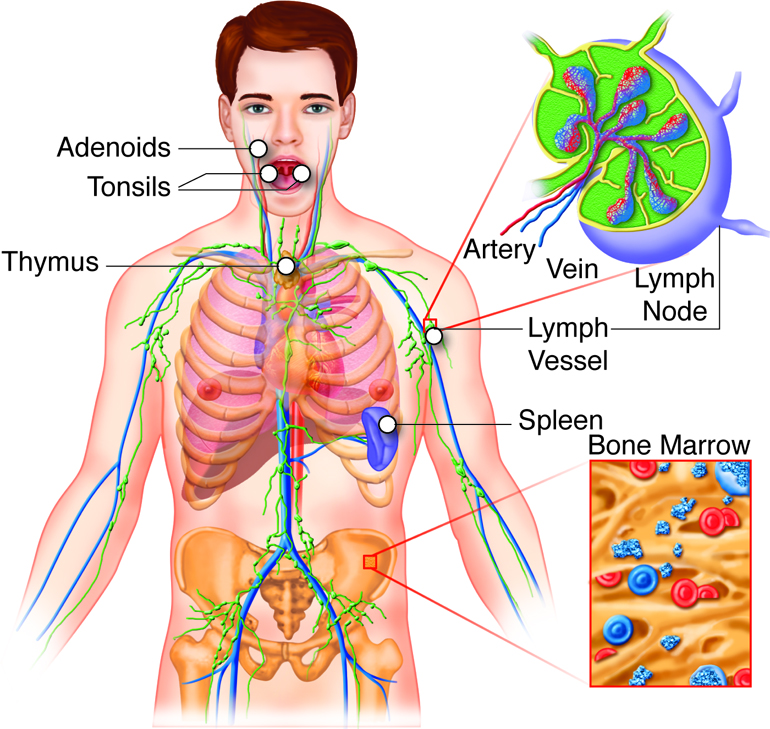46 Lymphatic System Introduction
Take any anatomy and/or physiology textbook or course, and chances are that the chapter dedicated to the lymphatic system will be short and lacking detail when compared to its mighty and well known sibling, the cardiovascular system. Maybe because of the prominence and the romantic notions ascribed to the heart and blood, the cardiovascular system has been studied much more extensively. Since its original description by Hippocrates, the lymphatic system has been neglected by both scientific and medical communities because of its vagueness in structure and function. “Rediscovered” in the 1600s as the venae albae et lacteae (“milky veins”), the lymphatic system was for long considered a secondary vascular system that supports the blood vascular system.
In fact, the lymphatic system has important functions ranging from transport of fats, returning leaked fluids to the blood, to housing the cells and many organs of the immune response. The immune system coordinates the activities required to respond to disease and infection. This response can provide two types of immunity:
Specific immunity, in which specialized cells (such as T and B cells) recognize specific foreign molecules called antigens within the body and respond to them.
Nonspecific immunity, in which the body uses several general methods such as physical barriers (that is, the skin and mucous membranes), fever, inflammation, specific action by immune cells, and enzyme activity to protect itself against general harmful agents.
Components of the Lymphatic System and Immunity
Our body is in constant exchange with the environment, through breathing, eating and other activities. Therefore, it is important to screen the body and its components regularly to identify foreign invaders that might enter during these activities (or in any other manner). Further, it is important to rapidly and effectively remove these invaders before they can cause significant harm. Our body has specialized transport systems to carry out these functions. The cardiovascular and lymphatic systems work together to transport excess fluids (blood and lymph fluid, respectively) away from body tissues. The cardiovascular and lymphatic systems also participate in the function of immunity, helping defend the body’s cells from foreign organisms that may enter the body tissues or fluids.

The major organs of the lymphatic and immune systems can be classified based on their role in lymphocyte maturation. Maturation of lymphocytes takes place within the red bone marrow and the thymus gland, which are primary lymphoid organs. Antigens become trapped within secondary lymphoid organs such as the lymph nodes, spleen, and tonsils. These organs are sites that contain lymphocytes for destruction of invading pathogens.
| Organ | Description |
|---|---|
| Tonsils and Adenoids | Adenoids are one of three sets of tonsils. They trap pathogens that enter through the mouth and nose. Also, the tonsils monitor the external environment that the mouth and nose are exposed to, and can react with an appropriate immune response for certain pathogens. |
| Thymus | A lobular (of or pertaining to a lobe) structure, which contains many immature, inactive lymphocytes. As the lymphocytes mature, they leave the thymus to attack infected cells in lymphatic tissues throughout the body. |
| Spleen | The largest of the lymphatic organs, it houses lymphocytes for potential immune response. Also, the resident phagocytes within the spleen perform the most basic function of removing cell debris from the blood. |
| Lymph Nodes | These house lymphocytes and macrophages, which destroy foreign material contained in the lymph fluid. |
| Lymph Vessels | These transport lymph fluid throughout the lymphatic system. |
| Red Bone Marrow | All of our blood cells are generated from red bone marrow stem cells. These stem cells differentiate into red blood cells, platelets, and several cells that play roles in immunity. These “immune cells” include lymphocytes, which carry out specific immunity, and neutrophils and macrophages (macrophages start as monocytes and mature into macrophages in the tissues), which are nonspecific phagocytic cells. |
While many people know that we are protected from foreign micro-organisms by an immune system, few people realize how the immune system is able to patrol the entire body. White blood cells of the immune system are produced in the red bone marrow and travel through the blood. They can leave blood capillaries to travel through tissues. White blood cells are then able to remove dead or damaged cells and “foreign” organisms they encounter and recognize specific foreign organisms again if necessary. Additionally, lymph collects from tissues and circulates through lymph vessels, making “rest stops” in discrete points throughout the body called lymph nodes or lymph organs. In these nodes and organs, including the spleen, tonsils and other tissue clusters, there are large collections of white blood immune cells. Lymph slowly travels through these organs ensuring that the lymphocytes have plenty of time to react to these foreign organisms in the lymph before returning it to the blood.

